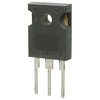-
A good PCB layout for optimal thermal performance involves placing the device near a thermal pad or a heat sink, using a large copper area for heat dissipation, and minimizing thermal resistance by using a thick copper layer and a thermal via array.
-
To ensure reliable operation at high temperatures, ensure that the device is operated within the recommended temperature range, use a suitable thermal interface material, and provide adequate heat sinking and airflow.
-
Key considerations for EMI filtering and noise reduction include using a pi-filter or a common-mode choke, placing the filter components close to the device, and using a shielded cable or a twisted pair for signal transmission.
-
To protect the device from overvoltage and overcurrent, use a voltage regulator or a TVS diode for overvoltage protection, and a fuse or a PTC resettable fuse for overcurrent protection.
-
Recommended soldering and assembly techniques include using a soldering iron with a temperature range of 250-260°C, applying a small amount of solder paste, and using a reflow oven or a hot air soldering station.
 STTH3002CW datasheet
by STMicroelectronics
STTH3002CW datasheet
by STMicroelectronics
 STTH3002CW datasheet
by STMicroelectronics
STTH3002CW datasheet
by STMicroelectronics